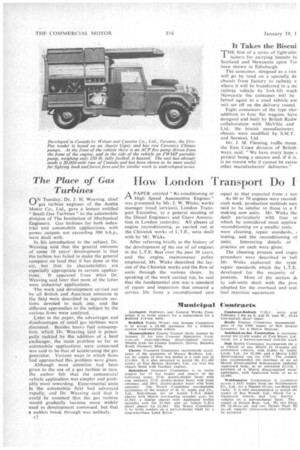The Place of Gas Turbines
Page 40

If you've noticed an error in this article please click here to report it so we can fix it.
r-IN Tuesday, Dr. J. H. Weaving, chief
gas turbine engineer of the Austin Motor Co., Ltd., gave a lecture entitled " Small Gas Turbines" to the automobile division of The Institution of Mechanical Engineers. Gas turbines for both industrial and automobile applications, with power outputs not exceeding 500 b.h.p., were dealt with.
In his introduction to the subject, Dr. Weaving said that the general outcome of some 10 years' development is that the turbine has failed to. make the general conquest on land that it has done in the air, but that its characteristics are . especially appropriate to certain applications. it appeared from what Dr. Weaving said later that most of the latter were industrial applications.
The work and development carried out by all British and American concerns in the field were described in separate sections devoted to each one, and the different approaches to the subject by the various firms were analysed...
Later in the paper, the advantages and disadvantages of small gas turbines were discussed. Besides heavy fuel consumption. which Dr. Weaving said is principally tackled by the addition of a heat exchanger, the main problem so far as automobile applications were concerned was said to be that of accelerating the gas generator. Various ways in which firms had. approached this problem were given.
Although most attention had been given to the use of a gas turbine in cars, the author felt that the commercial vehicle application was simpler and probably most rewarding. Experimental units in the automobile field had advanced rapidly, and Dr. Weaving said that it could be assumed that the gas turbine would gradually become more widely used as development continued, but that a sudden break through was unlikely. THE first of a series of light-allo: tainers for carrying biscuits bc Scotland and Newcastle upon Tyr been shown in Edinburgh.
The container, designed as a van will go by road on a specially de chassis from factory to railway si where it will be transferred to a mc railway vehicle by fork-lift track Newcastle the container, will be ferred again to a road vehicle an will set off on the delivery round.
Eight containers of the type sho, addition to four flat wagons, have designed and built by British Railw collaboration with McVitie and Ltd., the biscuit 'manufacturers. chassis were modified by S.M.T. and Service), Ltd.
Mr. J. M. Fleming, traffic mans, the East Coast division of British ways, said: "We have every hope project being a success and, if it is, is no reason why it cannot be extent other manufacturers' deliveries."












































































































